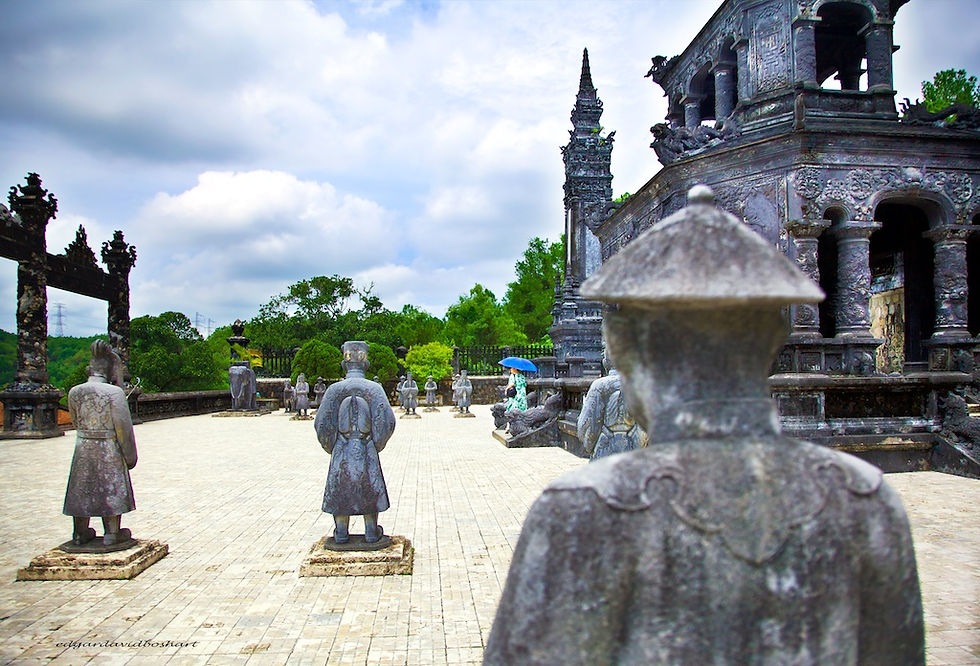Vietnam Redo: Emperors and Gods
- edgardavidboshart
- Dec 10, 2018
- 4 min read
(Hue, Vietnam, part 2)

Emperors and gods are sometimes (usually!) indistinguishable. In Asia, and especially looming China, central authority assumes the mantle of power that speaks of earth and heaven at the same time. People outside the palaces and forts in past political cycles hustled like serfs to fulfill the divine goals, but little was publicly disclosed about how the ruler(s) objectives are developed or executed. Vietnam’s governments before colonization and into the 20th Century, including the Nguyen Dynasty, adopted this model of social and practical leadership — emanating from richly robed sovereigns ensconced in elaborate enclaves clustered around the city of Hue, in central Vietnam.

Their mausoleums and tombs, preserved today in the forests scattered around the city, are as elaborate as the original households — the servants, soldiers and administrators memorialized in larger-than-life stone monuments.

Some visitors like to take a “selfie” with the rock witnesses to the secluded history of Vietnam. As for me, I look with suspicion and some discomfort at these remarkably lively dead beings, certain that they are holding back some vital secrets of the Court. Taking their photo for me is an effort to hopefully coax disclosure and possible insight into the psyche of their times.








The tomb of Emperor Khai Dinh, located on the edge of Hue in Chau Chu Mountain, was financed on the back of the peasants of his dominion. It demonstrates a complex mix of French and Eastern designs and is quite an enormous edifice that took a decade to build between 1920 and 1931.
The tomb features a reinforced concrete stele monument, as well as stone statues representing Mandarin bodyguards and administrators. The Palace interior swims in intricately designed glass and porcelain walls. The ceiling is decorated with nine intricate dragons.







The eastern dragon, or “liondragon” or Chinese fireball, likes to eat humans and pigs. Its imprint all around the palace of Khai Dinh confers a Potter-like (that’s "Harry Potter") aura to the place and establishes this dragon gatekeeper as the largest stone representation of the gnarly beast in all of Vietnam. (In the Potter series, The Goblet of Fire, four dragons are featured: (1) the Welsh Green confronted by Fleur Delacour, (2) the Chinese Fireball faced by Viktor Krum, (3) the Swedish Short-Snout faced by Cedric Diggory, and (4) the Hungarian Horntail faced by Harry Potter himself).
Nguyễn Ái Quốc (later known as Hồ Chí Minh) wrote a play about Khải Định called "The Bamboo Dragon.” Uncle Ho ridiculed him as being all grand appearance and ceremony but a powerless puppet of the French government. From 1919, the Emperor decreed that Vietnam cease using Chinese as the official written language and that its populace must use only romanized Vietnamese.


Gardens and mausoleums/palaces of other Dynasty members encircle Hue; some secluded behind metal gates and concrete and stone walls, elaborately embroidered with supernatural creatures. There is the typical attempt to imprint a harmony of the earthly with the natural flex and sway of the surrounding flora.



Worn beauty of the abstract and rigid







Outside of these extravagant royal domains, the Vietnamese non-royals tended rice fields and fished the sea and rivers in order to keep the federal coffers fertile. Their sacrifices under feudalism, then colonialism, and then communism and now pseudo-capitalism are an archive of human achievement built from the ground up. It is evident to me that basic principles of family cooperation and commercial determination are the real backbone of many Asians, and the Vietnamese in particular.


Their future lingers though between two competing world models today — both displayed by former psychological and real enemies — the US and China (although Korea is today increasingly visible and active as a supplier of the country’s secular needs, and tourism).
There are places, besides the imperial court, for residents of this country to relax and commune with nature and the holy. An Hien (House of Peace) is arguably the most beautiful and best known private traditional home n Hue, surrounded with apricot trees. "Like other ancient houses in Hue, a screen was installed at the entrance of the house to drive away evil spirits. There’s a pool in the house to ensure a harmony between yin and yang for the house. The house is built on wooden pillars without using iron nails, steel or cement”.

A place I dubbed the Town of Ancestors (a cemetery outside the walls of the Celestial Fort, 2008). A hallowed ground, heaven's First Class lounge, for the wealthier former inhabitants of Hue.

An Hien garden entrance




Some emperors did defer to higher powers than themselves, perhaps to curry favor from their subjects. Thien Mu pagoda, built in 1844 by Emperor Thieu Tri, features golden Buddha images, along with a big bell cast in 1710, and a stone turtle holding a marble stele inscribed in the 17th century.
The pagoda still functions as a monastery. In 1963, a Buddhist monk who lived here poured gasoline over his head on a street in Saigon and burned to death in protest against the American interference in South Vietnam. The car he used for his last travel is preserved for view on the monastery grounds. Children today gather daily to welcome tourists and visitors with cheerful smiles and well-planted questions intended to bond stranger and young inquisitors.
Thien Mu Pagoda and Monastery











Birds are important companions to the Vietnamese


Golden Buddha


(to be continued --- Ho Chi Minh City)

Comments